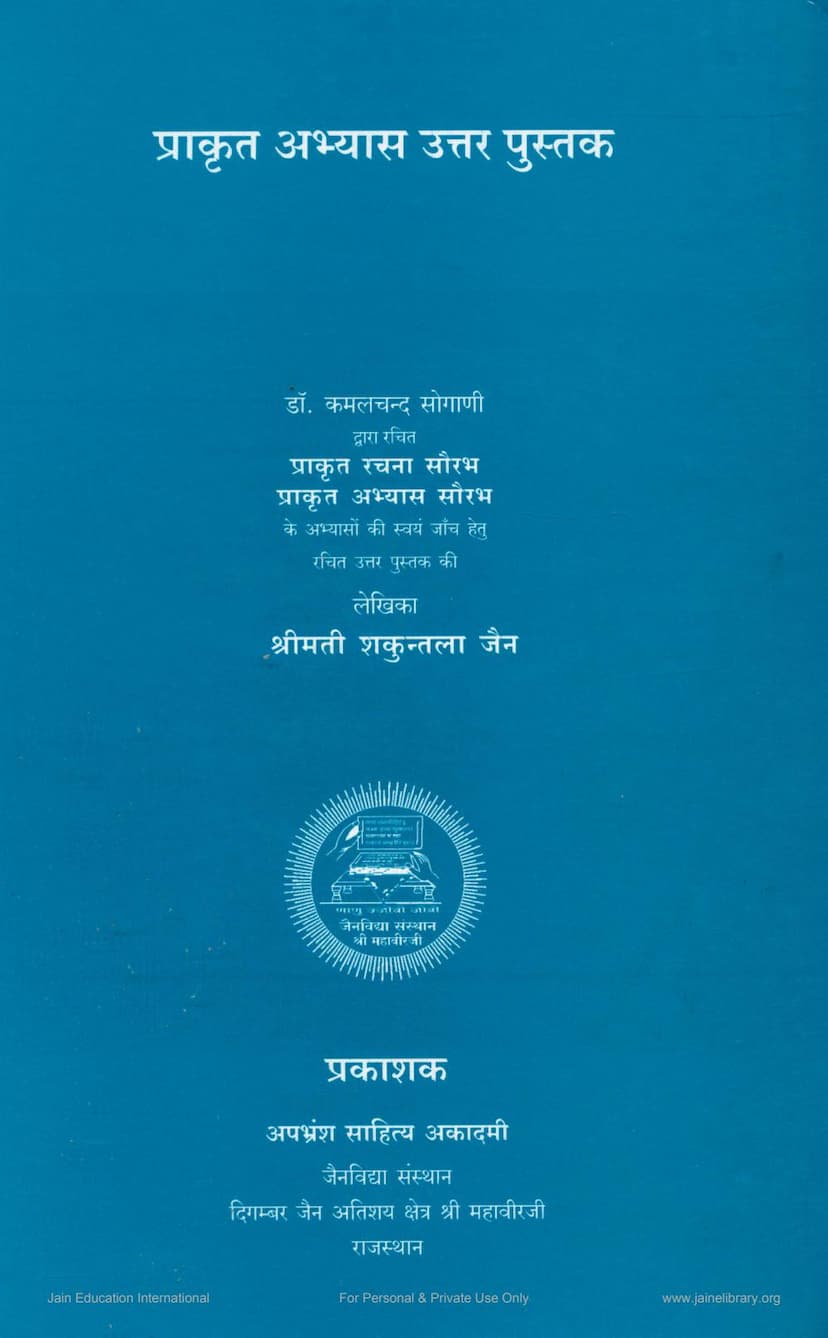Prakrit Abhyas Uttar Pustak
Added to library: September 2, 2025

Summary
This is a comprehensive summary of the provided Jain text, "Prakrit Abhyas Uttar Pustak" (प्राकृत अभ्यास उत्तर पुस्तक), authored by Kamalchand Sogani and Shakuntala Jain, published by Apbhramsa Sahitya Academy. The book serves as an answer key to the exercises found in "Prakrit Rachna Saurabh" and "Prakrit Abhyas Saurabh."
Overall Purpose and Content:
"Prakrit Abhyas Uttar Pustak" is designed as a self-study guide for students learning Prakrit. Its primary function is to provide the correct answers to the practice exercises in the companion books, enabling learners to verify their understanding and progress independently. The text covers a wide range of Prakrit grammar and vocabulary, systematically organized through numerous exercises (अभ्यास).
Key Areas Covered (Based on the Table of Contents and Exercise Examples):
The book meticulously progresses through various aspects of Prakrit grammar, including:
-
Verb Conjugation:
- Tenses: Present, Past, and Future tenses are thoroughly covered.
- Moods: Imperative (विधि एवं आज्ञा) and Conditional (हेत्वर्थक कृदन्त) moods are addressed.
- Verb Types: Both Transitive (सकर्मक क्रियाएँ) and Intransitive (अकर्मक क्रियाएँ) verbs are explained and practiced.
- Verb Forms: Various conjugations for different persons (first, second, third) and numbers (singular, plural) are presented and answered.
- Verb Roots and Suffixes: Extensive practice is provided on identifying and using different verb roots and their associated suffixes for various tenses and moods.
- Passive Voice (भाववाच्य) and Active Voice (कर्तृवाच्य): Exercises distinguish between and practice these voice forms.
- Causative Verbs (प्रेरणार्थक प्रत्यय): The use of causative suffixes is explained.
- Verbs with Specific Conjugations: Irregular verbs and those with common variations are addressed.
- Verbs related to states and actions: The exercises cover verbs describing actions like laughing (हस), dancing (णच्च), hiding (लुक्क), becoming angry (रूस), waking up (जग्ग), sitting (ठाय), going (गच्छ), and eating (खा).
-
Nouns and Pronouns:
- Declension: Practice in declining nouns and pronouns in various cases (Nominative, Accusative, Instrumental, Dative, Ablative, Genitive, Locative, Vocative) and numbers (singular, plural).
in Prakrit grammar, including:
- Gender and Number: Nouns are practiced in Masculine (पुल्लिंग), Feminine (स्त्रीलिंग), and Neuter (नपुंसकलिंग) genders, and singular and plural numbers.
- Noun Endings: Exercises focus on different noun stems, particularly those ending in '-a' (अकारान्त), '-ā' (आकारान्त), and vowels like '-i', '-ī', '-u', '-ū'.
- Case Endings: The book provides answers for noun forms in various grammatical cases (Vibhakti), such as प्रथमा (Nominative), द्वितीया (Accusative), तृतीया (Instrumental), चतुर्थी (Dative), पंचमी (Ablative), षष्ठी (Genitive), and सप्तमी (Locative).
- Pronoun Usage: Correct usage of pronouns in different contexts is also practiced.
- Declension: Practice in declining nouns and pronouns in various cases (Nominative, Accusative, Instrumental, Dative, Ablative, Genitive, Locative, Vocative) and numbers (singular, plural).
in Prakrit grammar, including:
-
Tenses and Participles:
- Past Participles (भूतकालिक कृदन्त): Exercises cover both active (कर्तृवाच्य) and passive (भाववाच्य) forms of past participles.
- Present Participles (वर्तमान कृदन्त): The usage of present participles is also practiced.
- Future Participles ( the book seems to cover future tense forms extensively, potentially through future active participles or future verbal forms).
-
Sentence Construction:
- Simple Sentences: Building basic sentences is a foundational element.
- Complex Sentences (मिश्रित वाक्य): Exercises involve constructing sentences with multiple clauses, often using conjunctions and relative pronouns.
-
Other Grammatical Concepts:
- Suffixes (प्रत्यय): Practice with various suffixes, including subjective suffixes (स्वार्थिक प्रत्यय) and those related to causative verbs (प्रेरणार्थक प्रत्यय).
- Adverbs (अव्यय): Correct usage of adverbs is included.
- Irregular Forms: Specific exercises address irregular verb conjugations and noun declensions.
Educational Approach:
The "Prakrit Abhyas Uttar Pustak" embodies a pedagogical approach that emphasizes:
- Self-Correction: It empowers students to independently check their work, fostering a sense of autonomy and accountability in their learning.
- Reinforcement: By providing answers, it helps reinforce grammatical rules and vocabulary learned in the primary texts.
- Comprehensive Practice: The sheer number and variety of exercises ensure thorough practice across all major grammatical areas.
- Accessibility: The clear structure, likely following the progression of the companion books, makes it easy for students to navigate and find specific answers.
Publisher and Context:
The publisher, Apbhramsa Sahitya Academy, is associated with Jain Vidya Sansthan Shri Mahavirji. This highlights the book's origin within an institution dedicated to the study and promotion of Jain scriptures and languages, with Prakrit being a significant language in Jain tradition, notably used by Lord Mahavir for his teachings. The catalog link and the publisher's information confirm its academic and religious context.
In essence, "Prakrit Abhyas Uttar Pustak" is a vital resource for anyone seriously undertaking the study of Prakrit, providing the necessary solutions to master the intricacies of this classical language.